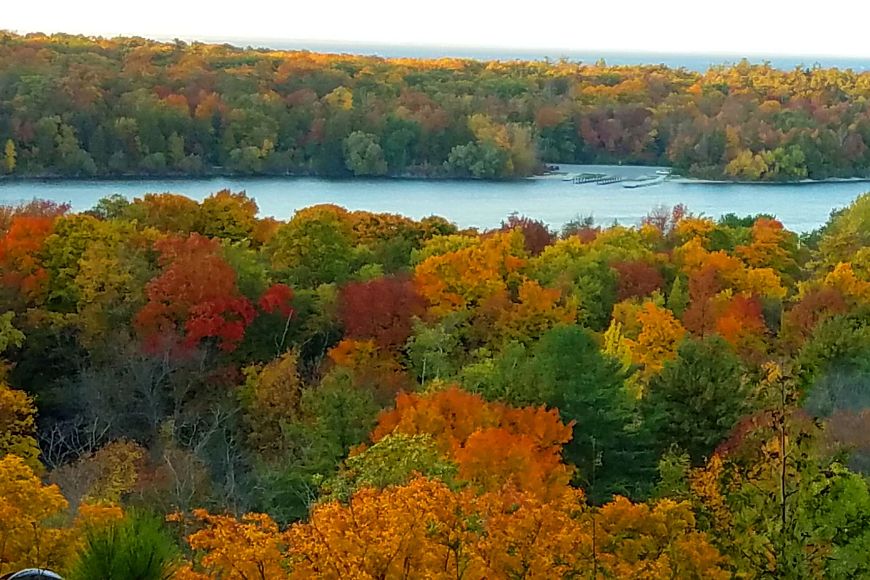Wisconsin Fall Color Report and viewing opportunities
Discover the fall colors in Wisconsin with the official Travel Wisconsin Fall Color Report.
 Erika Lambert
Erika Lambert
Wisconsin's state forests and parks offer a wealth of fall color viewing opportunities. Find a state forest, park recreation area or trail by searching online.
Because many of our state forests were formed around watersheds, visitors can admire the beautiful fall colors while enjoying recreation opportunities along our lakes, rivers and streams in a pristine, serene environment.
Science of fall leaf colors
Leaf color comes from pigments. Pigments are natural substances produced by leaf cells. The three pigments that color leaves are:
- chlorophyll (green);
- carotenoid (yellow, orange and brown); and
- anthocyanin (red).
Chlorophyll is the most important of the three. Without the chlorophyll in leaves, trees wouldn't be able to use sunlight to produce food.
Carotenoids create bright yellows and oranges in familiar fruits and vegetables. Corn, carrots, and bananas are just a few of the many plants colored by carotenoids.
Anthocyanins add the color red to plants, including cranberries, red apples, cherries, strawberries and others.
Chlorophylls and carotenoids are in leaf cells all the time during the growing season. But the chlorophyll covers the carotenoid - that's why summer leaves are green, not yellow or orange. Most anthocyanins are produced only in autumn, and only under certain conditions. Not all trees can make anthocyanin.
How leaves change color
As the Earth makes its 365-day journey around the sun, some parts of the planet will get fewer hours of sunlight at certain times of the year. In those regions, the days become shorter and the nights get longer. The temperature slowly drops. Autumn comes and then winter.
Trees respond to the decreasing amount of sunlight by producing less and less chlorophyll. Eventually, a tree stops producing chlorophyll. When that happens, the carotenoid already in the leaves can finally show through. The leaves become a bright rainbow of glowing yellows, sparkling oranges and warm browns. What about red leaves? Read on.
Do leaves change because of weather?
Perhaps you've noticed that in some years, the red fall colors seem brighter and more spectacular than in other years. The temperature and cloud cover can make a big difference in a tree's red colors from year to year.
When a number of warm, sunny autumn days and cool but not freezing nights come one after the other, it's going to be a good year for reds. In the daytime, the leaves can produce lots of sugar, but the cool night temperatures prevent the sugar sap from flowing through the leaf veins and down into the branches and trunk. Anthocyanins to the rescue! Researchers have found out that anthocyanins are produced as a form of protection. They allow the plant to recover nutrients in the leaves before they fall off. This helps make sure that the tree will be ready for the next growing season. Anthocyanins give leaves their bright, brilliant shades of red, purple and crimson.
The yellow, gold and orange colors created by carotenoid remain fairly constant from year to year. That's because carotenoids are always present in leaves and the amount does not change in response to the weather.
The amount of rain in a year also affects autumn leaf color. A severe drought can delay the arrival of fall colors by a few weeks. A warm, wet period during fall will lower the intensity, or brightness, of autumn colors. A severe frost will kill the leaves, turning them brown and causing them to drop early. The best autumn colors come when there's been:
- a warm, wet spring;
- a summer that's not too hot or dry; and
- a fall with plenty of warm sunny days and cool nights.
You can tell a tree from its colors
You can use the fall leaf color to help identify different tree species. Look for these leaf colors on the trees in your neighborhood:
- Oaks: red, brown or russet
- Hickories: golden bronze
- Dogwood: purple-red
- Birch: bright yellow
- Poplar: golden yellow
- Maple trees show a whole range of colors:
- Sugar maple: orange-red
- Black maple: glowing yellow
- Red maple: bright scarlet
Why leaves fall
A tree's roots, branches and twigs can endure freezing temperatures, but most leaves are not so tough. On a broadleaf tree like a maple or a birch, the tender, thin leaves -- made up of cells filled with water sap -- will freeze in winter. Any plant tissue unable to live through the winter must be sealed off and shed to ensure the tree's survival.
As sunlight decreases in autumn, the veins that carry sap into and out of a leaf gradually close. A layer of cells, called the separation layer, forms at the base of the leaf stem. When this layer is complete, the leaf is separated from the tissue that connected it to the branch, and it falls. Oak leaves are the exception. The separation layer never fully detaches the dead oak leaves, and they remain on the tree through winter.
Evergreen trees -- pines, spruces, cedars and firs -- don't lose their leaves, or needles, in winter. The needles are covered with a heavy wax coating and the fluids inside the cells contain substances that resist freezing. Evergreen leaves can live for several years before they fall and are replaced by new growth.
On the ground, fallen leaves are broken down by bacteria, fungi, earthworms and other organisms. The decomposed leaves restock the soil with nutrients and become part of the spongy humus layer on the forest floor that absorbs and holds rainfall.
